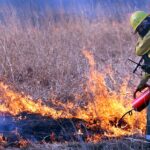06/24/10
While some Hoosiers felt the earthquake that occurred earlier this afternoon in Ontario, Canada, the Indiana Department of Homeland Security reminds all citizens that the state is also exposed to a serious threat of earthquakes along the New Madrid Seismic Zone (NMSZ) and the Wabash Valley Seismic Zone (WVSZ).
The New Madrid Seismic Zone (NMSZ) and the Wabash Valley Seismic Zone (WVSZ) are fault systems in the Central U.S. The NMSZ is located about 180 miles southwest of Evansville. The WVSZ is only about 10 miles west of Vincennes. Scientists predict that strong earthquakes in these seismic zones are certain to occur in the future.
“There are many simple steps you can take to make your home more earthquake ready, such as placing large items on lower shelves, and hanging heavy pictures away from beds,” says IDHS Executive Director Joe Wainscott. “But many other steps, like assembling a disaster kit, and establishing family communication and home evacuation plans, are the same whether you’re preparing for a winter storm, tornadoes, or an earthquake.”
Make sure everyone in your home knows how to use the fire extinguisher and age appropriate family members know how to shut off utilities.
Develop an emergency communication plan
- In case family members are separated from one another during an earthquake (a real possibility during the day when adults are at work and children are at school), develop a plan for reuniting after the disaster.
- Ask an out-of-state relative or friend to serve as the “family contact.” After a disaster, it is often easier to call long distance. Make sure everyone in the family knows the name, address and phone number of the contact person.
Assemble and maintain a disaster kit. Ten items to include in your family’s disaster kit are:
- Food and water for three days (includes a minimum one gallon of water per person, per day)
- Battery operated all hazards radio
- Flashlight
- Extra batteries for radio and flashlight
- First aid kit
- Extra clothing, sturdy shoes, rain gear, blankets, and personal hygiene items
- List of emergency phone numbers
- Important documents (copies of photo ID, social security card, insurance and banking information)
- Cash (Small bills. Power outages can limit ability to use ATMs and credit cards)
10. Special items (baby formula, insulin, life sustaining medication)
Comprehensive information and resources to help you prepare for earthquakes and other natural disasters are available on the IDHS website at www.in.gov/dhs/getprepared.













